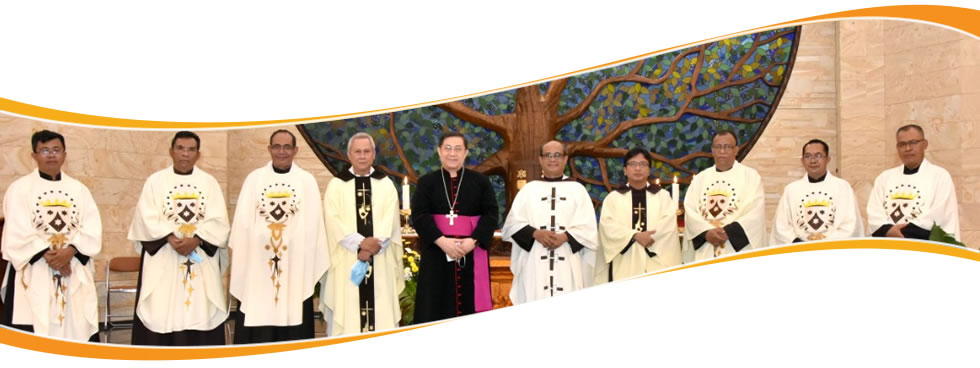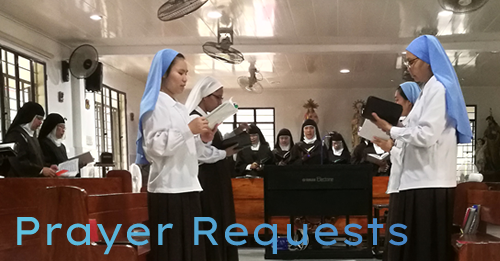Our Foundation on Mount Carmel
The Greek Monk, Phocas, records that “St. Berthold, “a monk white with age and invested with priestly dignity, came to Carmel in 1155, built a small chapel and collected ten brothers.” Exactly when and how these men came to settle around the fountain of Elijah in the wadi ‘ain es-Siah remains a point of conjecture. However, by the time they entered the valley forwards the end of the 12th century, western hermits had a long tradition and history.
In his writings, Jacques Vitry, bishop of Acre from 1216-1228, mentions the eremitical life in Palestine.
“Others in imitation of the holy anchorite, the prophet Elijah, led solitary lives on Mount Carmel, especially on that part … now called Haifa, near the well called Elijah’s Well, … where in little comb-like cells, those bees of the Lord laid up sweet spiritual honey.”
This group of hermits, a voluntary association probably composed mostly of lay people, approached the Patriarch of Jerusalem, Albert Avogadro (1150-1214), to write a formula of life establishing and changing the community of lay hermits into a religious order. The formula of life that these hermits received became their Rule and is often referred to as the “Rule of Saint Albert”. While the original document has been lost to history, modifications made in 1247 by Pope Innocent IV moved the Carmelites away from an eremitical to more of a mendicant life.
Of course, the settlement of the early Carmelites near the well of Elijah, the Prophet of the Book of Kings in the Bible, had an impact on the spirituality of the hermits. No less an authority than St. Anthony, a Christian monk of the third and fourth centuries, declares that “the ascetic should model his life as in a mirror after the example of the great Elijah.”
St. Jerome, a Saint and Doctor of the Church from the third and fourth centuries, proposed a list of figures to be emulated and concludes with “our leader Elijah, our Elisha, our sons of the prophets, who dwelt in the fields and solitary places and pitched their tents by the waters of the Jordan.” Many considered Elijah as the original hermit. From Elijah Carmelites learn to be people of the desert, with heart undivided, standing before God and entirely dedicated to his service, aflame with a passionate love for God.
The Marian inspiration on the Order comes from its earliest days. In an account of 1231, we know that an oratory dedicated to Mary under the title “Our Lady of the Place” stood in the midst of the cells on Mount Carmel. Over time, the hermits of Mount Carmel became known as the “Brothers of Our Lady of Mount Carmel.” Carmelites see in the Virgin Mary, the perfect image of all that they want and hope to be.
Movement to Europe
In approximately 1238, the Carmelites were forced to abandon their home on Mount Carmel due to incursions and persecutions by the Saracens. Most of the Carmelites went back to their country of origin in Europe to establish the Order there.
The loss of Mount Carmel provided the Order with the challenge of adapting to European life, particularly with the emerging mendicant movement of the religious orders— principally the Dominicans, Franciscans, and Augustinians.
At the General Chapter of 1297, the first Carmelite doctor at the University of Paris, is elected prior general. As all the previous prior generals had been hermits and Carmel a predominately eremitical existence, this was an important moment in the development of the Order.
Expansion in the Late Middle Ages
The relocation to their native countries also provided the Carmelites with the benefit of the emerging university system. In order to adequately prepare for ministry, Carmelites availed themselves of professional theological preparation. The Carmelites also became teachers and writers at the universities throughout Europe.
Inevitably, Carmelite life been much adapted because of the move from Mount Carmel to Europe. Yet, with such change came calls to return to what used to be. There were multiple efforts to better adapt to life to Europe while remaining faithful to the life they had previously lived on Mount Carmel. This became an ongoing tension in the life of every Carmelite. Multiple reforms develop over the coming centuries.
One reform started Carmelite nuns in the Order. From the earliest days in Europe women associated themselves with the Order in varying degrees. With papal approval in 1452, the incorporation became official with the women living in their own communities.
The Council of Trent and Its Aftermath
Most reforms remained movements within the Order. Some aspects of these reforms can be seen in the lives of Carmelites to this day. The Discalced reform of the 16th century, led by Teresa of Avila, resulted in a separate Order following the death of Saint Teresa and Saint John of the Cross.
The Protestant Reformation severely challenged the Order, particularly in northern Europe. Lutheranism gained little ground in Italy due to decisive action by the ecclesial authorities. The Inquisition in Spain kept heresy to a minimum. The contributions of the Order at the Council of Trent were modest. But the reforms of religious life called for in Trent were implemented by the Order.
Carmel in the Modern Period
Following the energy brought about by Trent, the Order continued to produce members noted for their holiness. The writings of this period also are noted as some of the finest ever produced.
At the dawn of the French Revolution, the Carmelite Order was established in a good portion of the world. Its 13,000 members were divided into 54 provinces. By the end of the French Revolution, the Order suffered great losses with its flourishing French provinces completely destroyed. By the end of the 19th century, the Order counted just 8 Provinces and 727 religious.
In the late 20th century it was this small band of religious and some phenomenal leaders who, with determination and courage, re-established the Order where it had been and in new lands.
Since the Second Vatican Council (1962-1965), Carmelites have reflected at length on their identity, on their charism, on what is fundamental in their lives. They have “returned to their roots” as the Council called upon all religious orders to do and have re-discovered that it means “to live in allegiance to Jesus Christ” in today’s world.
Carmel Today
Today the Carmelite Family, approximately 2,000 Carmelite men, 800 contemplative nuns, 2,300 members of affiliate congregations and 9,200 Lay Carmelites, live in 47 countries throughout the world. A rich ministerial life includes houses of prayer, centers for spiritual exercises, parishes, Marian sanctuaries, secondary schools, religious associations, media, and initiatives for Justice and Peace.
The Order’s members express their allegiance to Christ by their commitment to seek the face of the living God (contemplative dimension), in living in fraternity (community) and service (diakonia) in the midst of the people. The exemplary models of this life continue to be the prophet Elijah and the Blessed Virgin Mary as well as many of those Carmelites considered to have lived the life in an exemplary way over the centuries.
































